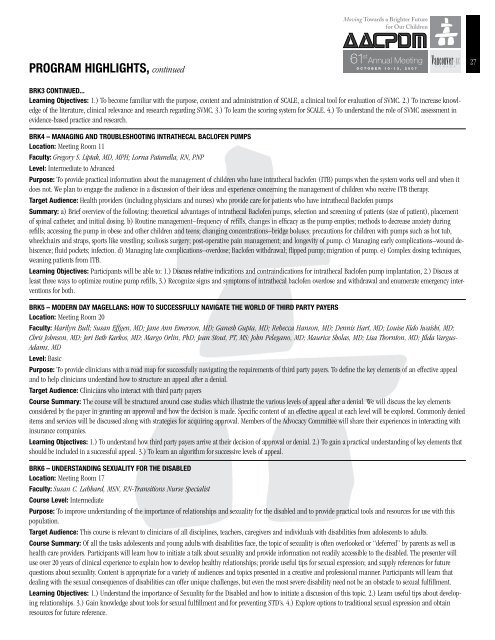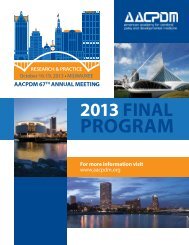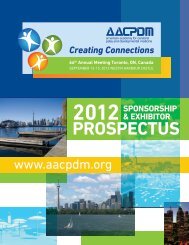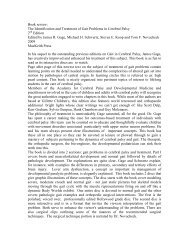Final Program - American Academy for Cerebral Palsy and ...
Final Program - American Academy for Cerebral Palsy and ...
Final Program - American Academy for Cerebral Palsy and ...
Create successful ePaper yourself
Turn your PDF publications into a flip-book with our unique Google optimized e-Paper software.
<strong>Program</strong> HigHligHTs, continued<br />
brk3 ConTinued...<br />
learning objectives: .) To become familiar with the purpose, content <strong>and</strong> administration of SCALE, a clinical tool <strong>for</strong> evaluation of SVMC . 2 .) To increase knowledge<br />
of the literature, clinical relevance <strong>and</strong> research regarding SVMC . 3 .) To learn the scoring system <strong>for</strong> SCALE . 4 .) To underst<strong>and</strong> the role of SVMC assessment in<br />
evidence-based practice <strong>and</strong> research .<br />
brk4 – managing <strong>and</strong> TroublesHooTing inTraTHeCal baClofen PumPs<br />
location: Meeting Room<br />
faculty: Gregory S. Liptak, MD, MPH; Lorna Patanella, RN, PNP<br />
level: Intermediate to Advanced<br />
Purpose: To provide practical in<strong>for</strong>mation about the management of children who have intrathecal baclofen (ITB) pumps when the system works well <strong>and</strong> when it<br />
does not . We plan to engage the audience in a discussion of their ideas <strong>and</strong> experience concerning the management of children who receive ITB therapy .<br />
Target audience: Health providers (including physicians <strong>and</strong> nurses) who provide care <strong>for</strong> patients who have intrathecal Baclofen pumps<br />
summary: a) Brief overview of the following: theoretical advantages of intrathecal Baclofen pumps, selection <strong>and</strong> screening of patients (size of patient), placement<br />
of spinal catheter, <strong>and</strong> initial dosing . b) Routine management–frequency of refills, changes in efficacy as the pump empties; methods to decrease anxiety during<br />
refills; accessing the pump in obese <strong>and</strong> other children <strong>and</strong> teens; changing concentrations–bridge boluses; precautions <strong>for</strong> children with pumps such as hot tub,<br />
wheelchairs <strong>and</strong> straps, sports like wrestling; scoliosis surgery; post-operative pain management; <strong>and</strong> longevity of pump . c) Managing early complications–wound dehiscence;<br />
fluid pockets; infection . d) Managing late complications–overdose; Baclofen withdrawal; flipped pump; migration of pump . e) Complex dosing techniques,<br />
weaning patients from ITB .<br />
learning objectives: Participants will be able to: .) Discuss relative indications <strong>and</strong> contraindications <strong>for</strong> intrathecal Baclofen pump implantation, 2 .) Discuss at<br />
least three ways to optimize routine pump refills, 3 .) Recognize signs <strong>and</strong> symptoms of intrathecal baclofen overdose <strong>and</strong> withdrawal <strong>and</strong> enumerate emergency interventions<br />
<strong>for</strong> both .<br />
brk5 – modern day magellans: HoW To suCCessfully navigaTe THe World of THird ParTy Payers<br />
location: Meeting Room 20<br />
faculty: Marilyn Bull; Susan Effgen, MD; Jane Ann Emerson, MD; Ganesh Gupta, MD; Rebecca Hanson, MD; Dennis Hart, MD; Louise Kido Iwaishi, MD;<br />
Chris Johnson, MD; Jeri Beth Karkos, MD; Margo Orlin, PhD; Jean Stout, PT, MS; John Pelegano, MD; Maurice Sholas, MD; Lisa Thornton, MD; Jilda Vargus-<br />
Adams, MD<br />
level: Basic<br />
Purpose: To provide clinicians with a road map <strong>for</strong> successfully navigating the requirements of third party payers . To define the key elements of an effective appeal<br />
<strong>and</strong> to help clinicians underst<strong>and</strong> how to structure an appeal after a denial .<br />
Target audience: Clinicians who interact with third party payers<br />
Course summary: The course will be structured around case studies which illustrate the various levels of appeal after a denial . We will discuss the key elements<br />
considered by the payer in granting an approval <strong>and</strong> how the decision is made . Specific content of an effective appeal at each level will be explored . Commonly denied<br />
items <strong>and</strong> services will be discussed along with strategies <strong>for</strong> acquiring approval . Members of the Advocacy Committee will share their experiences in interacting with<br />
insurance companies .<br />
learning objectives: .) To underst<strong>and</strong> how third party payers arrive at their decision of approval or denial . 2 .) To gain a practical underst<strong>and</strong>ing of key elements that<br />
should be included in a successful appeal . 3 .) To learn an algorithm <strong>for</strong> successive levels of appeal .<br />
brk6 – undersT<strong>and</strong>ing sexualiTy <strong>for</strong> THe disabled<br />
location: Meeting Room 7<br />
faculty: Susan C. Labhard, MSN, RN-Transitions Nurse Specialist<br />
Course level: Intermediate<br />
Purpose: To improve underst<strong>and</strong>ing of the importance of relationships <strong>and</strong> sexuality <strong>for</strong> the disabled <strong>and</strong> to provide practical tools <strong>and</strong> resources <strong>for</strong> use with this<br />
population .<br />
Target audience: This course is relevant to clinicians of all disciplines, teachers, caregivers <strong>and</strong> individuals with disabilities from adolescents to adults .<br />
Course summary: Of all the tasks adolescents <strong>and</strong> young adults with disabilities face, the topic of sexuality is often overlooked or “deferred” by parents as well as<br />
health care providers . Participants will learn how to initiate a talk about sexuality <strong>and</strong> provide in<strong>for</strong>mation not readily accessible to the disabled . The presenter will<br />
use over 20 years of clinical experience to explain how to develop healthy relationships; provide useful tips <strong>for</strong> sexual expression; <strong>and</strong> supply references <strong>for</strong> future<br />
questions about sexuality . Content is appropriate <strong>for</strong> a variety of audiences <strong>and</strong> topics presented in a creative <strong>and</strong> professional manner . Participants will learn that<br />
dealing with the sexual consequences of disabilities can offer unique challenges, but even the most severe disability need not be an obstacle to sexual fulfillment .<br />
learning objectives: .) Underst<strong>and</strong> the importance of Sexuality <strong>for</strong> the Disabled <strong>and</strong> how to initiate a discussion of this topic . 2 .) Learn useful tips about developing<br />
relationships . 3 .) Gain knowledge about tools <strong>for</strong> sexual fulfillment <strong>and</strong> <strong>for</strong> preventing STD’s . 4 .) Explore options to traditional sexual expression <strong>and</strong> obtain<br />
resources <strong>for</strong> future reference .<br />
27







